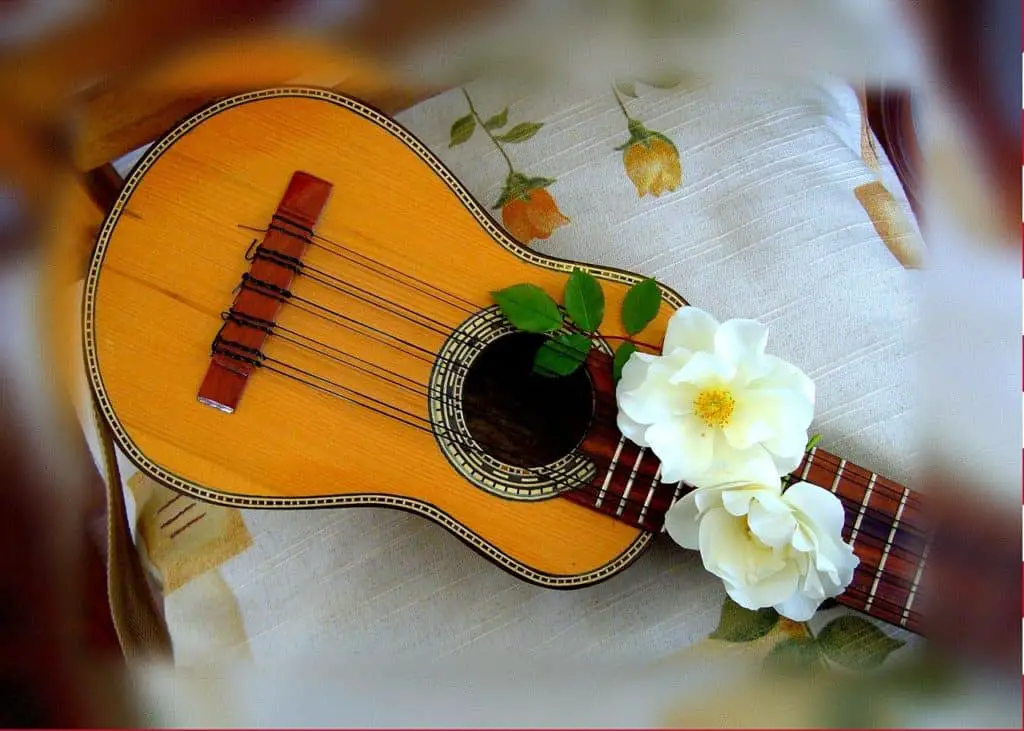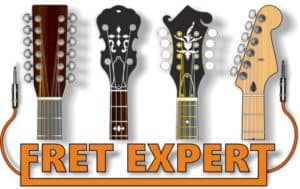If you’re reading this blog, the chances are you’ve already decided to investigate the intriguing world of the charango and ronroco in a little more detail. Hopefully, I can point you in the right direction!
The difference between a ronroco and charango is size and pitch. The Ronroco body shape is angular, whereas the charango resembles a very small classical guitar with an oversized headstock. The bigger ronroco is tuned an octave lower than the charango.
The ronroco is far newer than the charango and has only been around since the 1980s (more on the history of both instruments is below).
The body shape of a ronroco is unlike any other instrument you’re likely to come across, whereas the charango is about the size of a ukulele.
Covered in this Article:
The Difference in Sound Between The Ronroco and Charango
The tuning for both the charango and Bolivian version of the ronroco (an octave lower) is ‘GCEAE’, with the ‘G’ being nearest to the player’s chin. The ronroco is tuned to an octave lower than its smaller counterpart, or in fourths and fifths.
To illustrate this, here are two excellent samples of the instruments being played. The first is Benn Jordan playing the Ronroco, which he says is his favourite instrument:
The second is a more candid video of a charango, played in a music store in La Paz, Bolivia:
What is a Charango and Where are Charangos From?
As you can see from the video above, the charango is a little Andean folk instrument with a rounded wooden back and 10 strings arranged in 5 pairings.
It can be found throughout the whole Andean region, encompassing Bolivia, Argentina, Chile, Peru and Ecuador.
The origin of the charango dates back to Spanish Conquistadors who brought over an instrument called the vihuela da mano, an early relative of the guitar.
Because early artisans had limited experience working and shaping wood, they sourced the body of the instrument from the unfortunate little armadillo – an animal that was readily available and easy to trap. The armored shell (or carapace) was then attached to the soundboard/top of the instrument, providing a ready-made body or resonating chamber.
Today, most charangos are built entirely from wood, with only a few traditional quirquincho (pronounced keer-keen-cho) making their way onto the market. Unsurprisingly, the direct translation of quirquincho (a word of Quechua origin) means armadillo! Quechua is an indigenous language widely spoken in the whole Andean region.
Traditionally, charangos feature heavily at fiestas, weddings and curiously, even funerals!
Examples of the charango in popular music include:
- Simon & Garfunkel’s ‘El Condor Pasa’, a traditional tune with lyrics by Paul Simon, accompanied by Los Incas.
- Cachapaya, a number twelve hit for British pseudo-Andean folk group, Incantation
- Duncan, again by a solo Paul Simon, backed by Jorge Milchberg of Los Incas.
What is a Ronroco Instrument, and Where Is It From?
In comparison with the charango, the ronroco is a relatively new instrument invented by Gonzalo Hermosa of the Bolivian folk music group, Los Kjakas (pronounced los key-ar-kas) in the 1980s.
The 10 strings are always arranged in pairs and are manufactured from nylon or a plastic compound called Nylgut® (invented by the Aquila company).
A typical ronroco will be around 75-80cm long, with a scale length in the region of 46-50cm. The scale length is the distance between the nut and the saddle.
Other than the GCEAE octave tuning, commonly referred to as ‘Bolivian tuning’, two other regional variations are popular with ronroco players:
- The first (DGBEB) is tuned a fourth lower than standard charango tuning and comes from the ‘Argentine’ region of the Andes.
- The second comes in at a whole tone lower (CFADA) or in musical terms, a fifth lower than the charango. This tuning is popular in Chile and as an alternative tuning in Bolivia.
The pronunciation of the ronroco involves a heavy rolling of the ‘r’ sound: rron-rrow-co.
Is a Ronroco the Same as a Charangon?
Physically, a charangon looks like a bigger version of a charango, but shares many of the characteristics of the ronroco, particularly with regard to the tuning.
As the instrument is a little smaller than the ronroco, it tends to adhere to the fourths and fifths tuning convention mentioned above, rather than the full octave tuning employed by most Bolivian musicians.
A charangon will range in size from around 74-77cm in length with a scale of 42-51cm. The relationship between a charango and a charangon, is similar to a violin and viola, whereas a charango and ronroco could be compared with a viola and a cello, being an octave apart.
Tonally, the ronroco could loosely be referred to as a baritone charango, much akin to the size difference between a soprano ukulele and its baritone sibling.
Which Woods Are Charangos and Ronrocos Made Of?
Most makers (known as luthiers) will source as many of their tonewoods from the available indigenous trees in their particular region as much as possible.
Typical construction materials include naranjillo (Narran-hee-yo) for the body, white spruce pine for the top, ebony for the fingerboard and jacaranda (hacka-randa) for the bridge.
The saddle and nut generally utilize bone, which is very hard-wearing. Alternatively, plastic is used on some of the cheaper instruments.

What is a Walaycho? Is it a Charango?
A smaller cousin of the charango is also popular in Andean folk music. It’s called the walaycho (or sometimes the hualaycho or walaychu – pronounced Wul-eye-cho).
In Argentina it’s called the Maulincho (Mow [as in cow] leen-cho). It’s tuned like the ronroco’s fourths (DGBEB) and fifths tunings (CFADA), but an octave higher. Walaychu in Quechua can mean either a lazy or evil man.
Where Can I get a Ronroco or Charango From?
I’ve written a buyer’s guide to both the charango and the ronroco, which you can read here.
If you’re looking for chord bibles, which strings to buy and other information, you can visit my recommended products page for both the ronroco and charango.
I also give tips on how to tune a ronroco, and how to tune a charango in this article, too.
